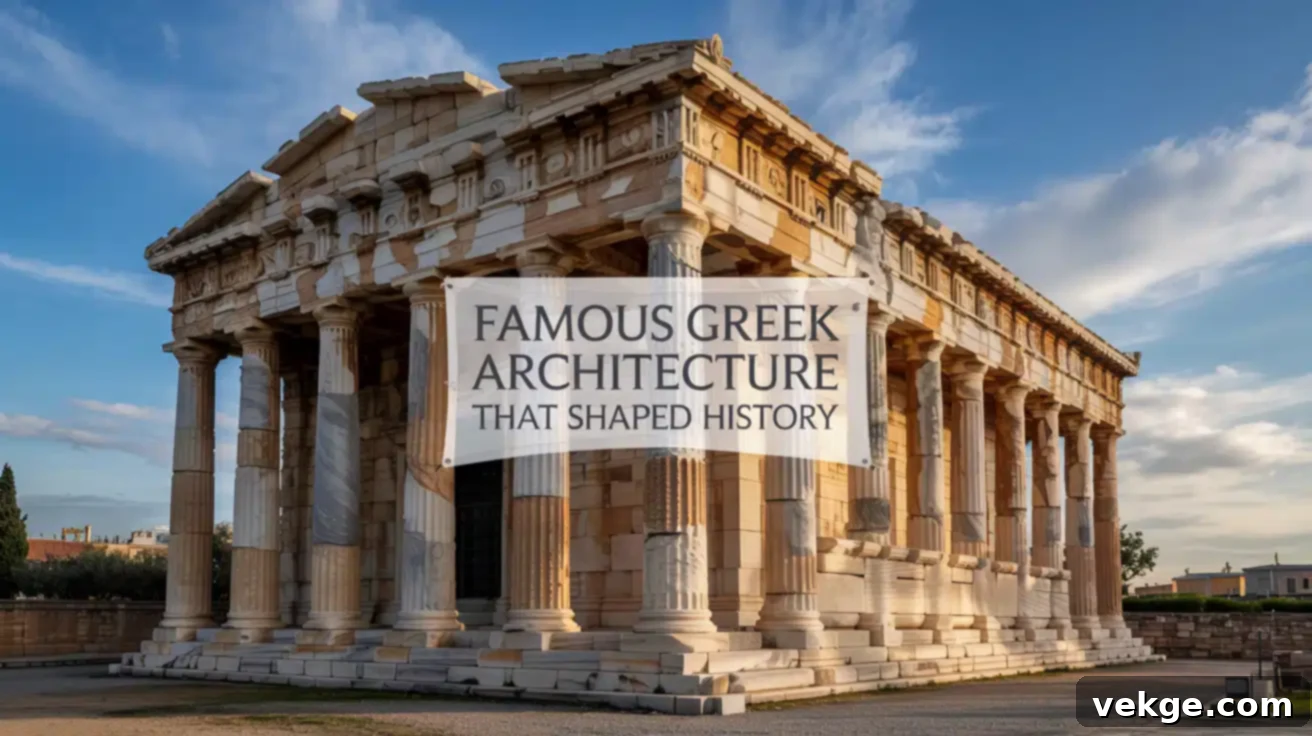The Enduring Legacy of Ancient Greek Architecture: Classical Designs, Iconic Structures, and Modern Influence
Have you ever paused to admire a grand building with stately columns and a distinctive triangular pediment atop its facade? Chances are, you’re observing the timeless influence of ancient Greek architecture. For over two millennia, the Greeks pioneered building designs so remarkably beautiful and functionally sophisticated that their principles continue to be replicated and revered in architectural masterpieces worldwide. These celebrated Greek architectural marvels showcase an extraordinary blend of artistic skill, mathematical precision, and aesthetic balance that continues to inspire architects and designers today.
Greek architectural styles are predominantly found in structures intended to convey importance, permanence, and dignity. The ancient Greeks masterfully discovered and applied fundamental rules for creating buildings that evoke a sense of perfect harmony and “just rightness” to the human eye. This captivating blend of artistry and engineering laid the groundwork for much of Western architectural tradition.
In this comprehensive guide, we will delve deep into the fascinating world of ancient Greek architecture, exploring its defining characteristics, the distinct architectural orders, and an array of its most famous and enduring structures.
Overview of Ancient Greek Architecture
The genesis of Greek architecture can be traced back to mainland Greece and the Aegean islands, emerging prominently between 900 and 700 BCE. It rapidly gained renown for its unparalleled beauty, structural integrity, and perfect proportional balance. Characterized by imposing stone columns, often supporting a heavy entablature and pediment, Greek buildings typically featured spacious interiors or open peristyles designed to accommodate religious ceremonies and public gatherings. Their construction adhered to rigorous mathematical principles governing dimensions, spatial relationships, and the precise fitting of various structural components.
Temples were undoubtedly the most significant and sacred buildings within Greek city-states (poleis), each meticulously constructed as a dedicated dwelling for one of the revered Olympian gods or goddesses. The historical narrative of Greek building styles unfolds through several distinct phases:
- Early Period (700-500 BCE): During this formative era, Greek builders transitioned from less durable wooden structures to more permanent stone temples. This shift marked the beginning of their quest for monumental and lasting edifices, reflecting a growing mastery of stone masonry.
- Golden Age (500-323 BCE): This was the zenith of Greek architectural achievement. Magnificent structures such as the Parthenon in Athens were erected, embodying the pinnacle of classical design, proportion, and artistic embellishment. The architectural innovations and aesthetic standards set during this period became the benchmark for centuries to come.
- Hellenistic Period (323-31 BCE): Following the conquests of Alexander the Great, Greek architectural styles spread far and wide, influencing regions including Egypt, the Near East (modern-day Turkey, Syria), and even parts of India. This expansion led to larger and more elaborate structures, though often retaining the core principles of classical Greek design.
A little-known fact that often surprises modern observers is that ancient Greek buildings, which appear pristine white today due to centuries of weathering, were originally painted in vibrant and striking colors. Hues of blue, red, gold, and other pigments adorned friezes, metopes, and even columns, presenting a much more colorful and dynamic appearance than what we perceive from their ruins.
Key Features of Greek Architecture
Several distinctive elements make ancient Greek architecture instantly recognizable and have contributed to its enduring appeal and influence:
1. Columns and Architectural Orders
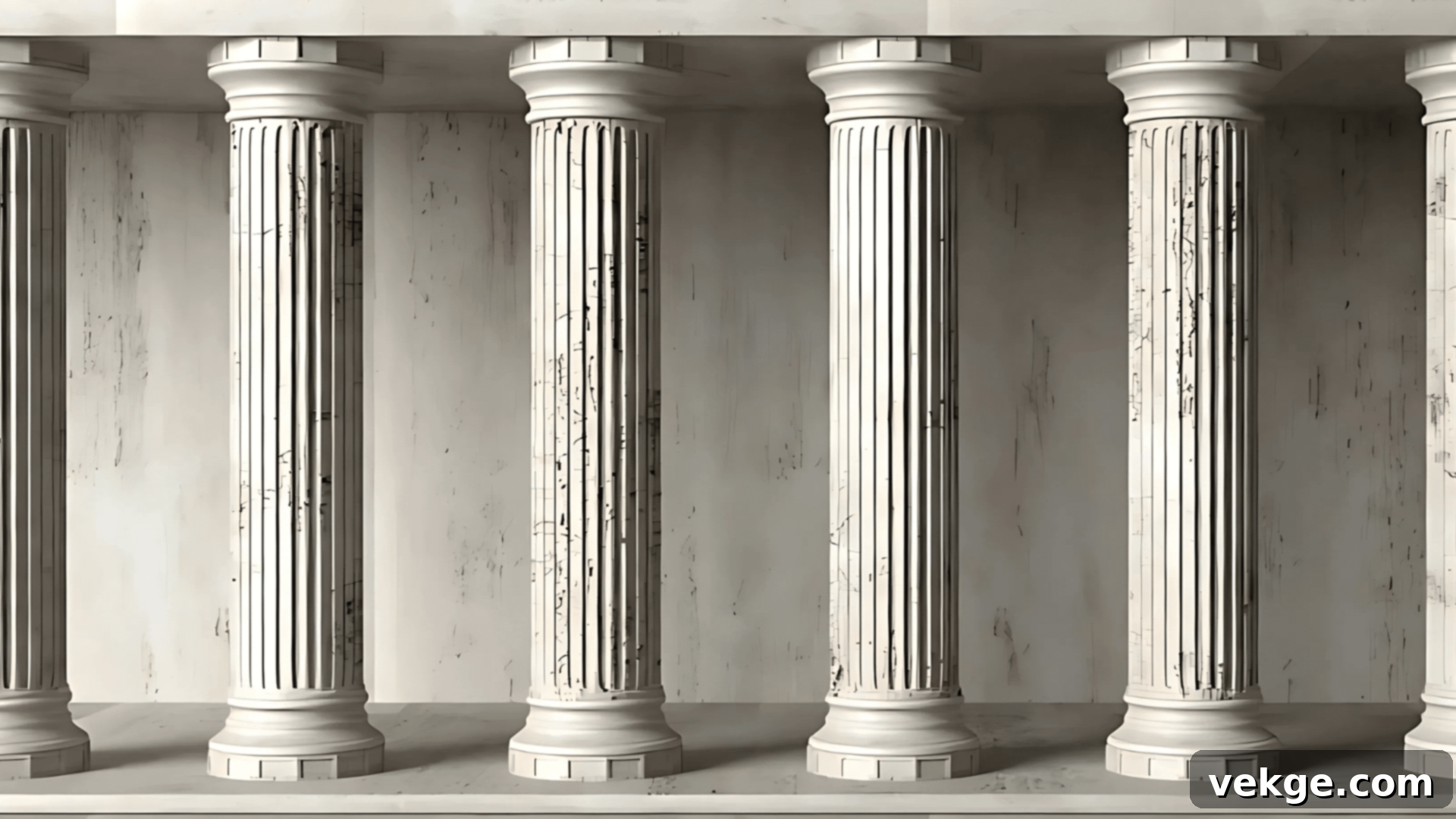
Columns are perhaps the most iconic feature of Greek architecture, serving both structural and aesthetic purposes. The Greeks developed three primary styles, or “orders,” for their columns, each with distinct characteristics that conveyed different sentiments and were chosen based on the building’s purpose and location. These columns not only supported massive roofs but also created elegant colonnades around buildings, defining space and guiding the eye. To correct for optical illusions, Greek architects ingeniously made columns slightly wider at the bottom and subtly tapered towards the top, a technique known as entasis, making them appear perfectly straight and solid to the viewer.
2. Symmetry and Proportion
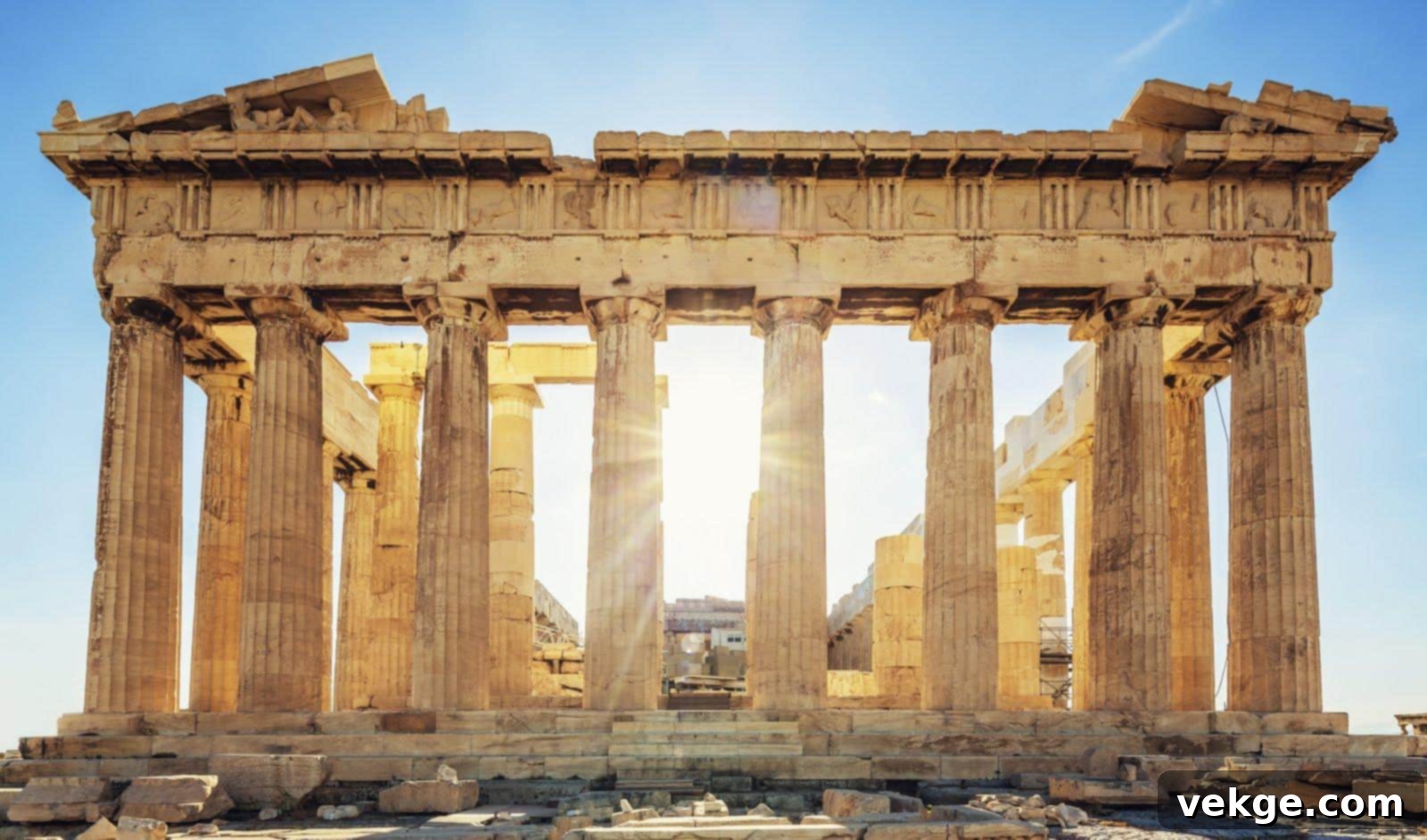
A fundamental principle in Greek architectural design was symmetry, meaning buildings were often designed to appear identical on both sides of a central axis. This mirrored balance was not merely a design choice but reflected the Greek pursuit of order, harmony, and perfect mathematical ratios, often derived from the golden ratio. Main entrances were typically centered, with meticulously balanced elements extending to the left and right. Temple floors, for example, were frequently laid out as perfect rectangles, their dimensions carefully calculated to achieve a sense of ideal proportion and visual stability.
3. Masterful Use of Stone
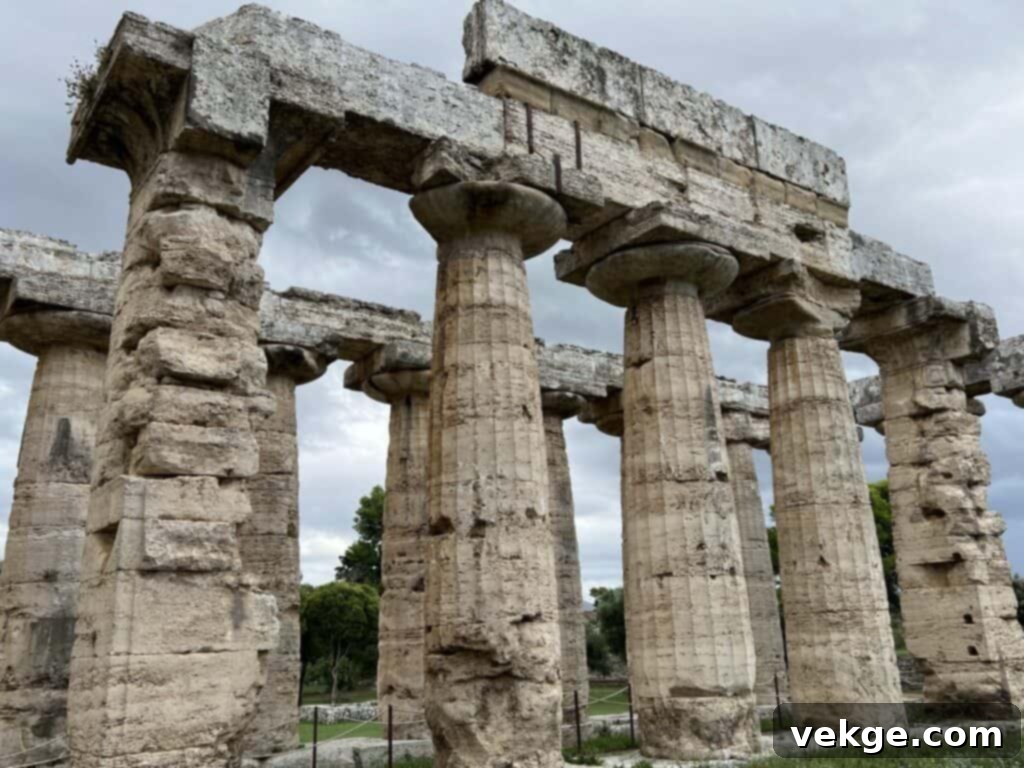
Unlike earlier cultures that relied on wood, the Greeks predominantly constructed their monumental buildings from durable limestone and, most famously, marble. This choice of material ensured that their structures would endure for centuries, conveying a sense of permanence and grandeur. Greek masons were unparalleled in their ability to cut and shape massive stone blocks with such precision that they often fit together seamlessly without the need for mortar or cement. White marble, particularly Pentelic marble from quarries near Athens, was their preferred material, especially for temples and other public buildings, lending a luminous quality to their architecture.
4. Open-Air Design Principles

Many Greek buildings embraced an open-air philosophy, utilizing colonnades rather than solid walls to define spaces. This created a sense of lightness and accessibility. Their renowned theatres, for instance, were entirely open to the sky, integrating the natural environment into the performance experience. Inner courtyards and peristyles within buildings were common, allowing ample natural light and fresh air to circulate. This open design was perfectly suited to Greece’s warm and sunny climate, creating comfortable and airy spaces for public life and religious ceremonies.
5. The Architectural Orders: Doric, Ionic, and Corinthian
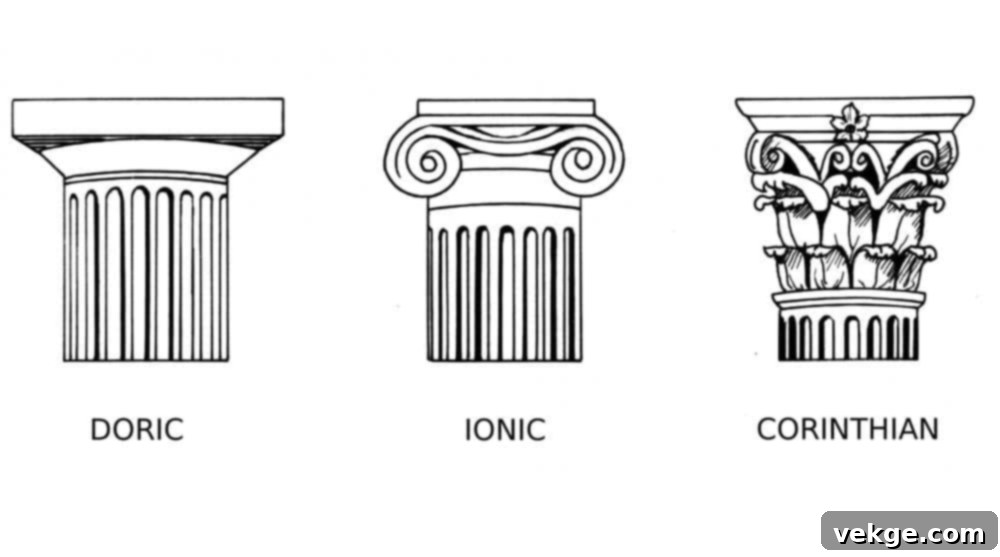
The three architectural orders — Doric, Ionic, and Corinthian — represent distinct systems of proportion and decoration, primarily defined by their column types and entablature. These orders provided a standardized framework for Greek builders:
- The Doric Order: This is the oldest and simplest of the three orders, characterized by sturdy, fluted columns that typically rest directly on the stylobate (the temple platform) without a base. Its capital (the top part of the column) is plain and cushion-like. The entablature features a frieze composed of triglyphs (vertically grooved panels) and metopes (plain or sculpted panels). The Doric order conveys a sense of strength, austerity, and masculine robustness.
- The Ionic Order: Emerging later, the Ionic order is more slender and elegant than the Doric. Its most distinctive feature is the capital, adorned with graceful scroll-like volutes (resembling rams’ horns or seashells). Ionic columns typically rest on a molded base and have a more decorative frieze, often continuous with sculpture. This order suggests refinement, grace, and a more feminine aesthetic.
- The Corinthian Order: The most ornate and elaborate of the three, the Corinthian order developed much later and became particularly popular during the Roman era. Its capital is richly decorated with stylized acanthus leaves and small volutes. While similar in shaft and base to the Ionic order, the Corinthian’s elaborate capital makes it the most visually striking and often used to signify opulence and grandeur.
Some Famous Ancient Greek Architectural Wonders
The following are 20 iconic examples that exemplify the brilliance and diversity of ancient Greek architecture:
1. The Parthenon of Athens
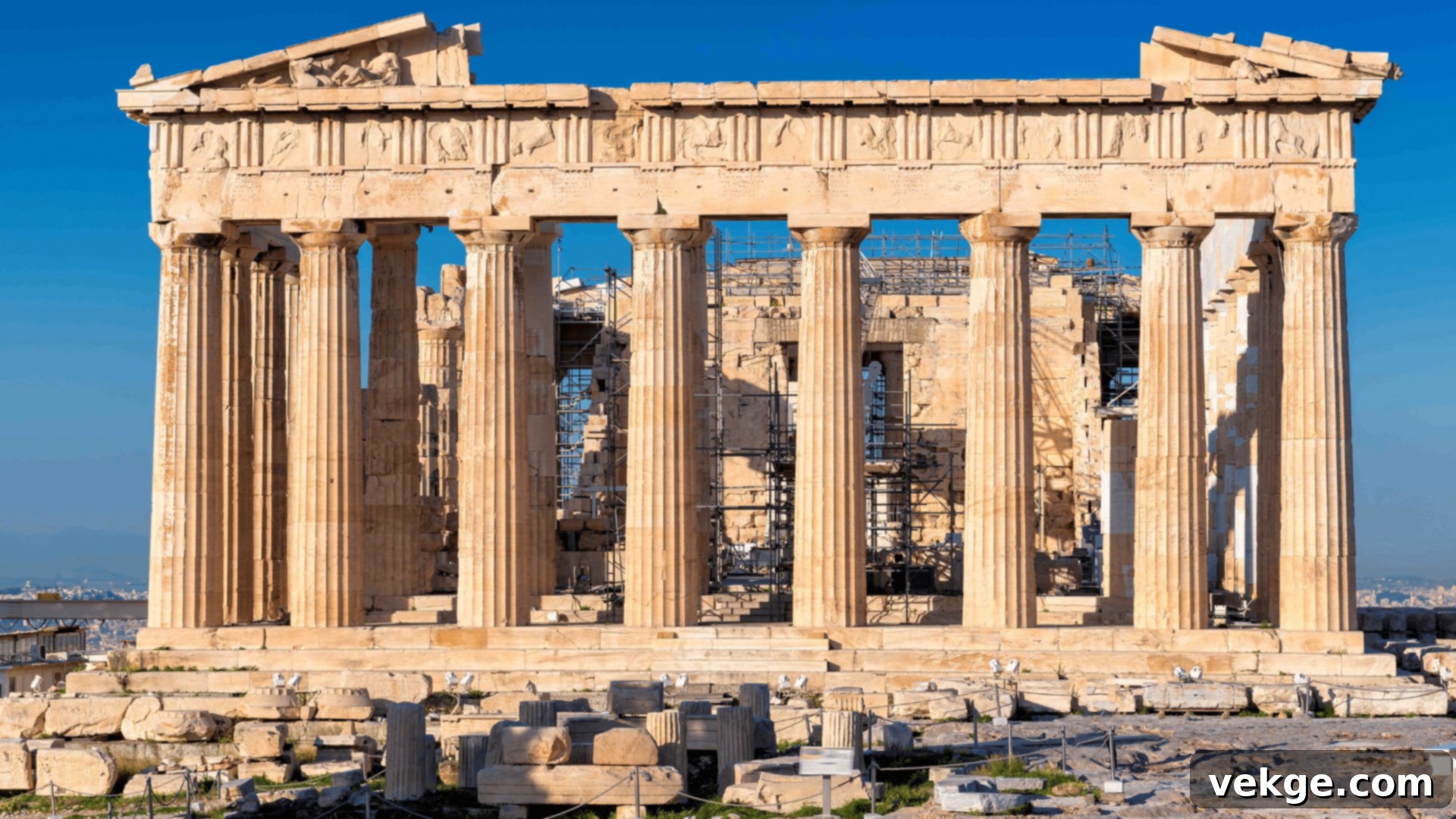
Perched majestically atop the Acropolis in Athens, the Parthenon stands as the quintessential symbol of ancient Greek democracy and architectural achievement. This Doric temple was dedicated to the goddess Athena Parthenos, the patron deity of Athens, and was constructed between 447 and 432 BCE during the height of the Athenian Empire under Pericles. Built almost entirely from exquisite Pentelic marble, the Parthenon embodies perfect mathematical ratios and optical refinements that make it appear flawless. It once housed a colossal chryselephantine (gold and ivory) statue of Athena, crafted by Phidias, and was adorned with elaborate sculptural friezes and pediments depicting mythological scenes. Despite enduring centuries of earthquakes, warfare, pollution, and weathering, the Parthenon continues to inspire. Extensive restoration efforts initiated in the 1970s aim to preserve what remains of this irreplaceable historical treasure. Today, it not only represents Athens but also serves as a global emblem for the foundational principles of Western civilization, art, and democratic governance.
2. The Erechtheion of Athens
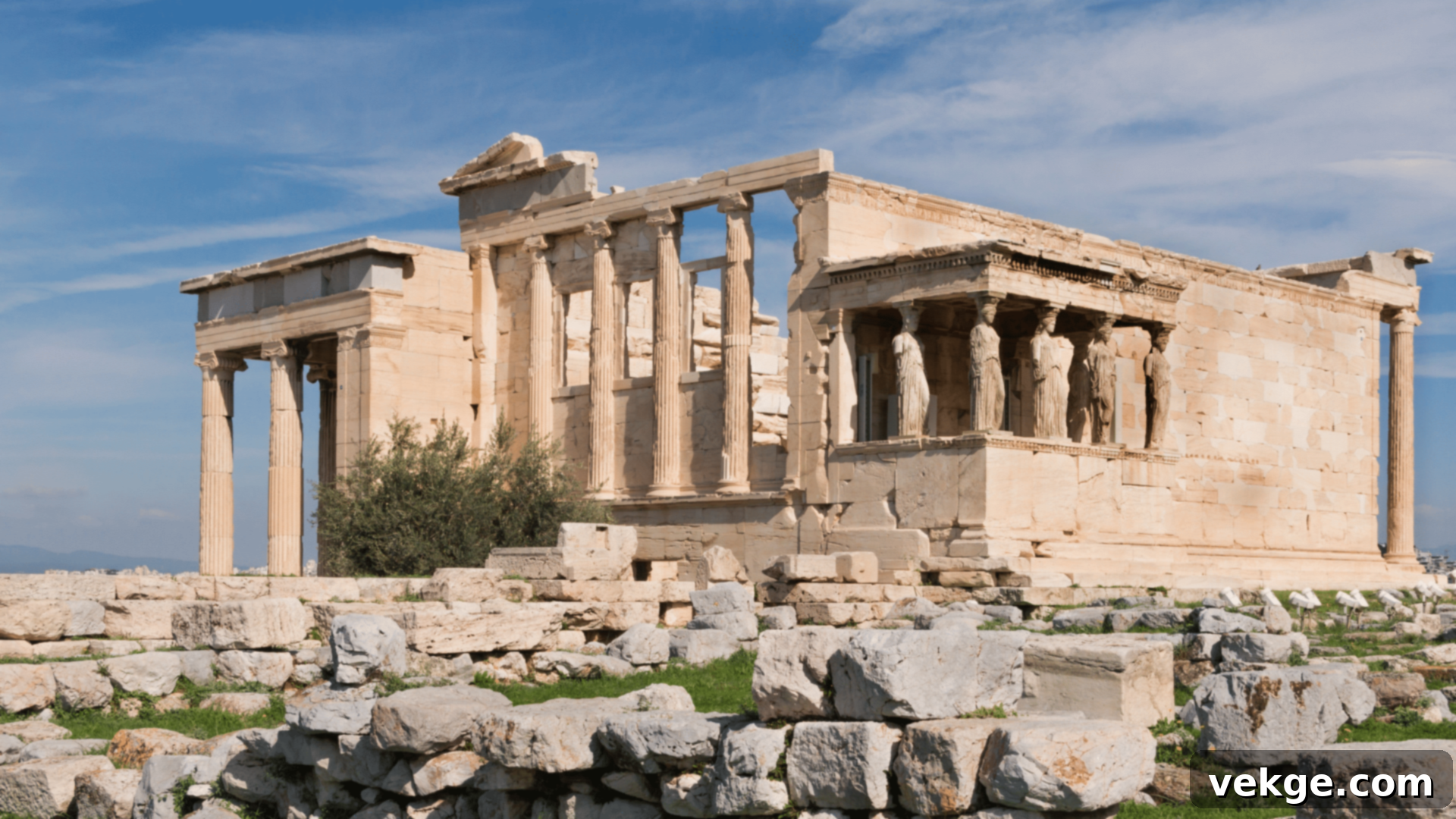
Also located on the Athenian Acropolis, the Erechtheion is a unique and captivating ancient Greek temple built around 420 BCE. Unlike the symmetrical Parthenon, the Erechtheion is famous for its unconventional, asymmetrical design. This architectural irregularity was necessitated by the uneven terrain on which it was built and the need to incorporate several highly sacred sites, including the marks believed to be left by Poseidon’s trident and Athena’s olive tree. Its most celebrated feature is the exquisite Porch of the Caryatids, where six gracefully sculpted female figures serve as load-bearing columns, supporting the roof with elegant dignity. These iconic caryatids replace the traditional columns seen in most other Greek buildings, adding to the temple’s distinctiveness. The Erechtheion honored multiple deities, primarily Athena and Poseidon, and marked mythical events central to Athens’ foundation. While the original Caryatid statues are now preserved in museums to protect them, expertly crafted copies stand proudly at the temple site, allowing visitors to appreciate their timeless beauty.
3. Temple of Zeus at Olympia
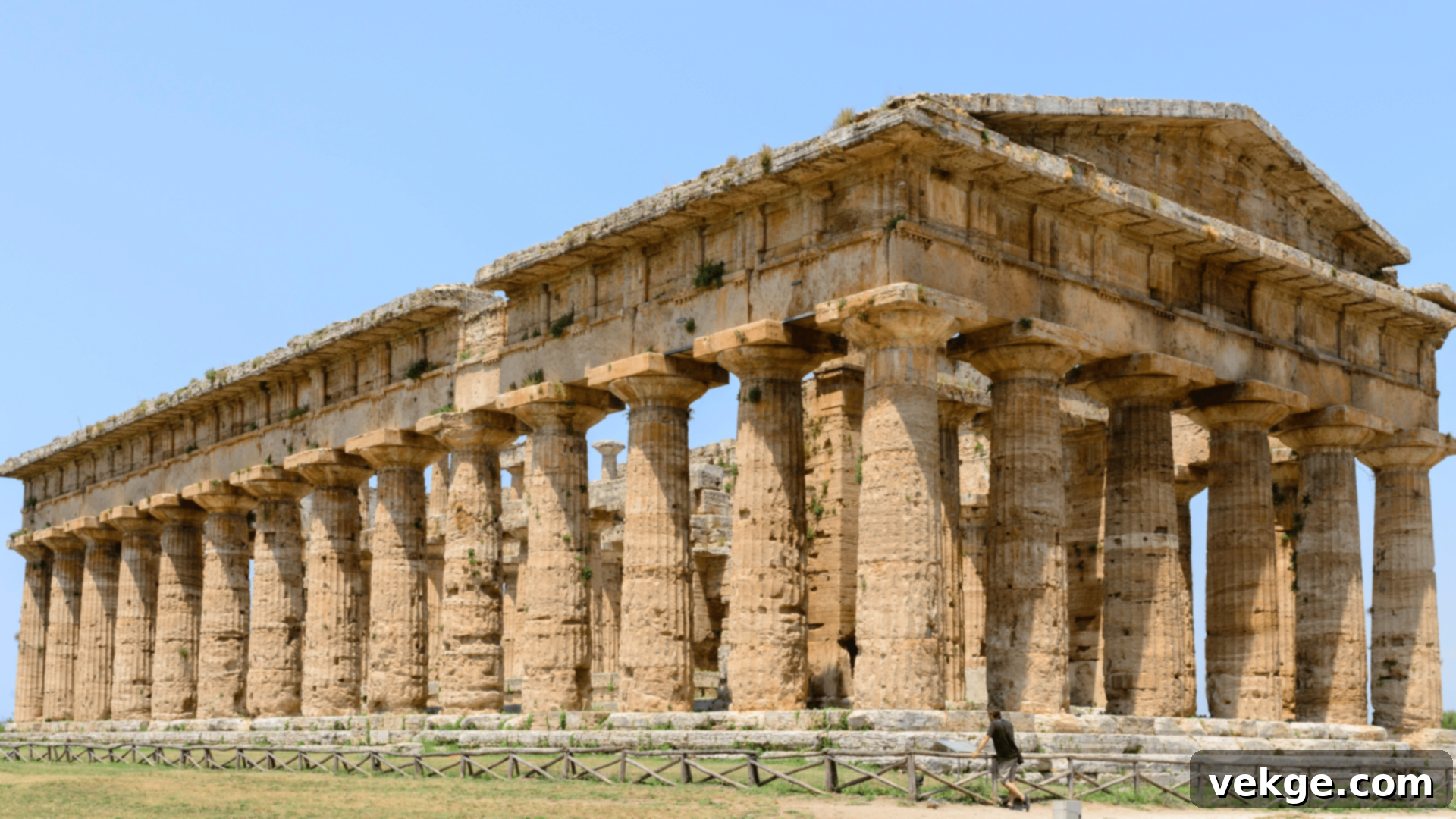
The Temple of Zeus at Olympia was one of the most revered religious edifices in ancient Greece, serving as the central sanctuary of the Olympic Games. Constructed between 472 and 456 BCE, this monumental Doric temple was primarily built to house the legendary cult statue of Zeus, king of the gods – one of the Seven Wonders of the Ancient World. The temple itself was colossal, built from local limestone and meticulously covered with a layer of white stucco to mimic the appearance of costly marble. Its exterior was encircled by a peristyle of tall, imposing Doric columns. The massive gold and ivory statue of Zeus, crafted by Phidias, was said to be so grand it almost touched the ceiling. Today, only the ruins remain, a testament to the destructive power of earthquakes and floods that brought the temple down centuries ago. The famous statue disappeared long ago, likely destroyed in a fire in Constantinople. Visitors to the archaeological site of Olympia can still explore the temple’s vast foundation and scattered remnants of its fallen columns, offering a powerful impression of its former grandeur and significance.
4. Temple of Apollo at Delphi
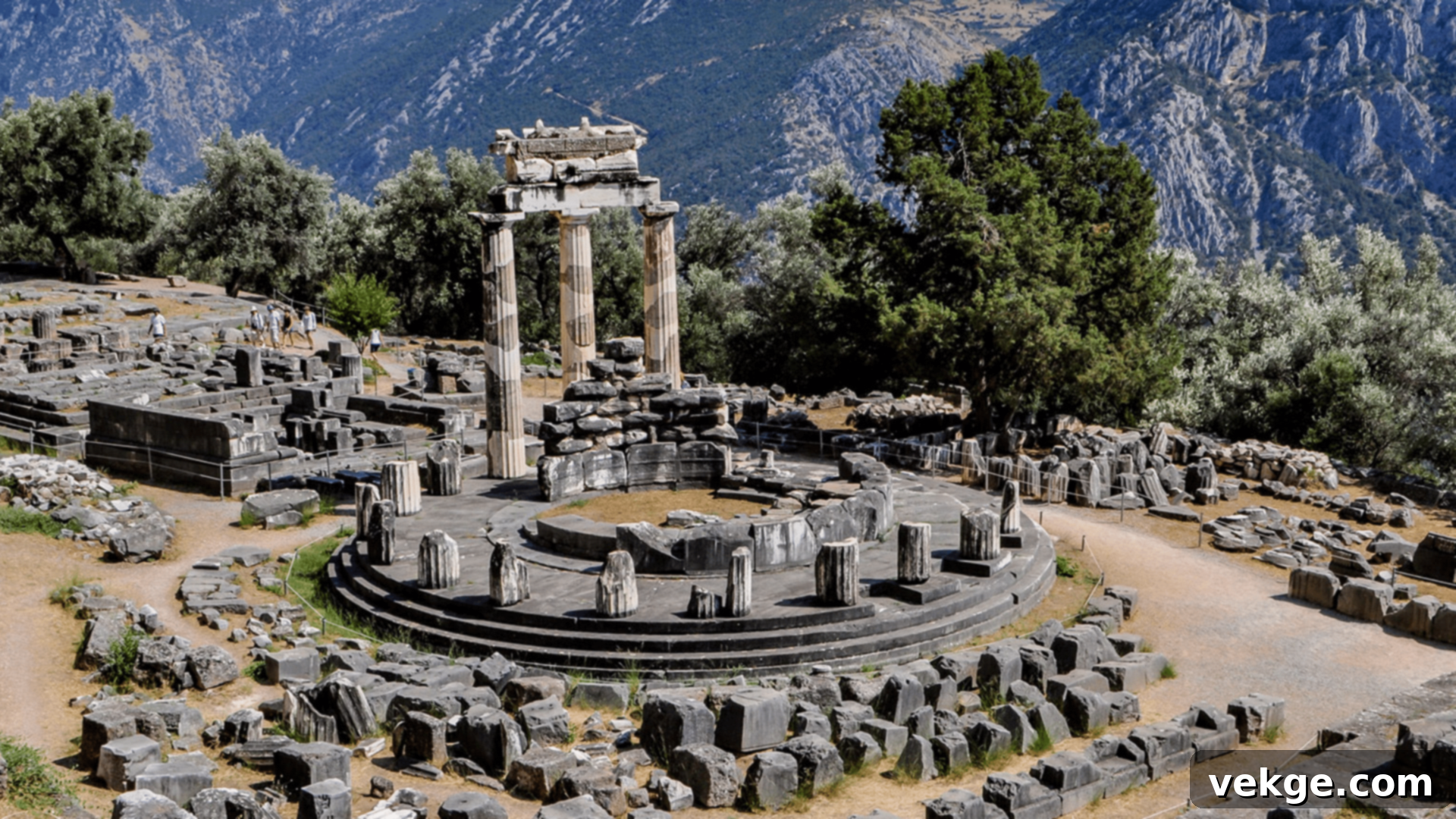
The Temple of Apollo at Delphi, rebuilt in the 4th century BCE after earlier versions were destroyed, was the spiritual heart of the ancient Greek world. It served as the revered home of the famous Oracle of Delphi, where the priestess Pythia would enter a trance-like state to deliver prophecies believed to emanate directly from the god Apollo. Located within a sprawling sanctuary complex dedicated to Apollo, the temple was constructed from limestone and showcased the classic Doric style, featuring six columns across its front facade. The inner sanctum, known as the adyton, was the sacred chamber where the Oracle performed her mystical pronouncements. Inscribed on the temple walls were famous maxims that guided ancient Greek morality, such as “Know thyself” and “Nothing in excess.” Although largely in ruins today, the remaining columns, foundations, and a palpable sense of history continue to convey the site’s immense former grandeur and its profound spiritual importance to ancient Greek civilization, drawing visitors to its dramatic mountain setting.
5. Theatre of Epidaurus
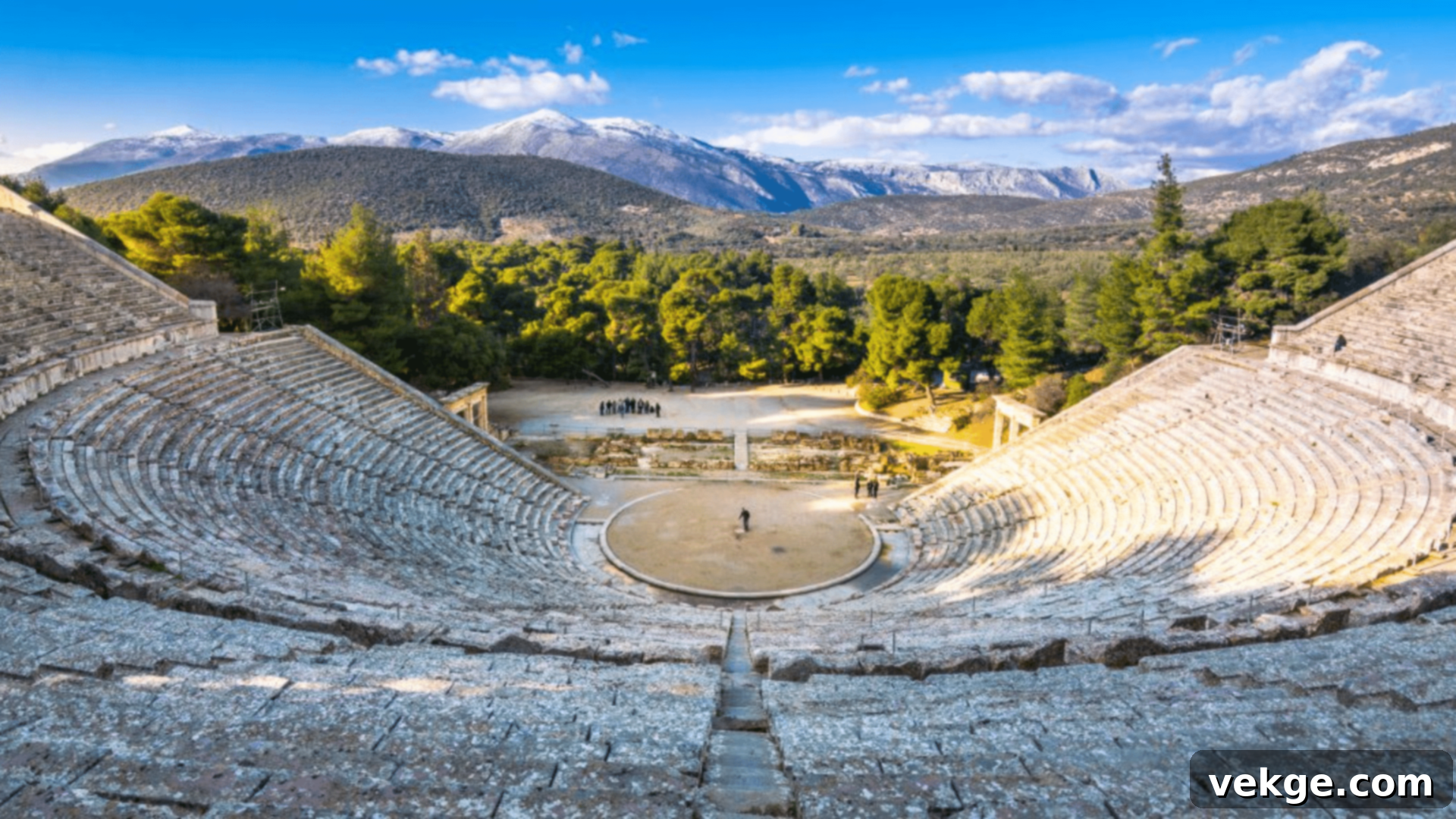
The Theatre of Epidaurus, built around 340-330 BCE, is nestled within the ancient Greek healing sanctuary of Asclepius in Epidaurus. It is widely celebrated as one of the best-preserved ancient Greek theatres and is globally renowned for its extraordinary acoustics. Even today, a whispered word or the delicate sound of a coin dropping on the central stage can be heard with astonishing clarity from the very highest rows of seats, demonstrating an unparalleled mastery of sound engineering. The theatre boasts a nearly perfect circular orchestra and 55 rows of meticulously crafted stone seating, capable of accommodating up to 14,000 spectators. Its construction was an integral part of the sanctuary dedicated to Asclepius, the god of medicine, as ancient Greeks believed that attending dramatic performances contributed to the healing of both body and mind. Remarkably, the theatre remains in such exceptional condition that it is still actively used for annual summer performances of ancient Greek drama, standing as a living testament to the engineering brilliance, aesthetic beauty, and functional genius of ancient Greek architecture.
6. Acropolis of Athens
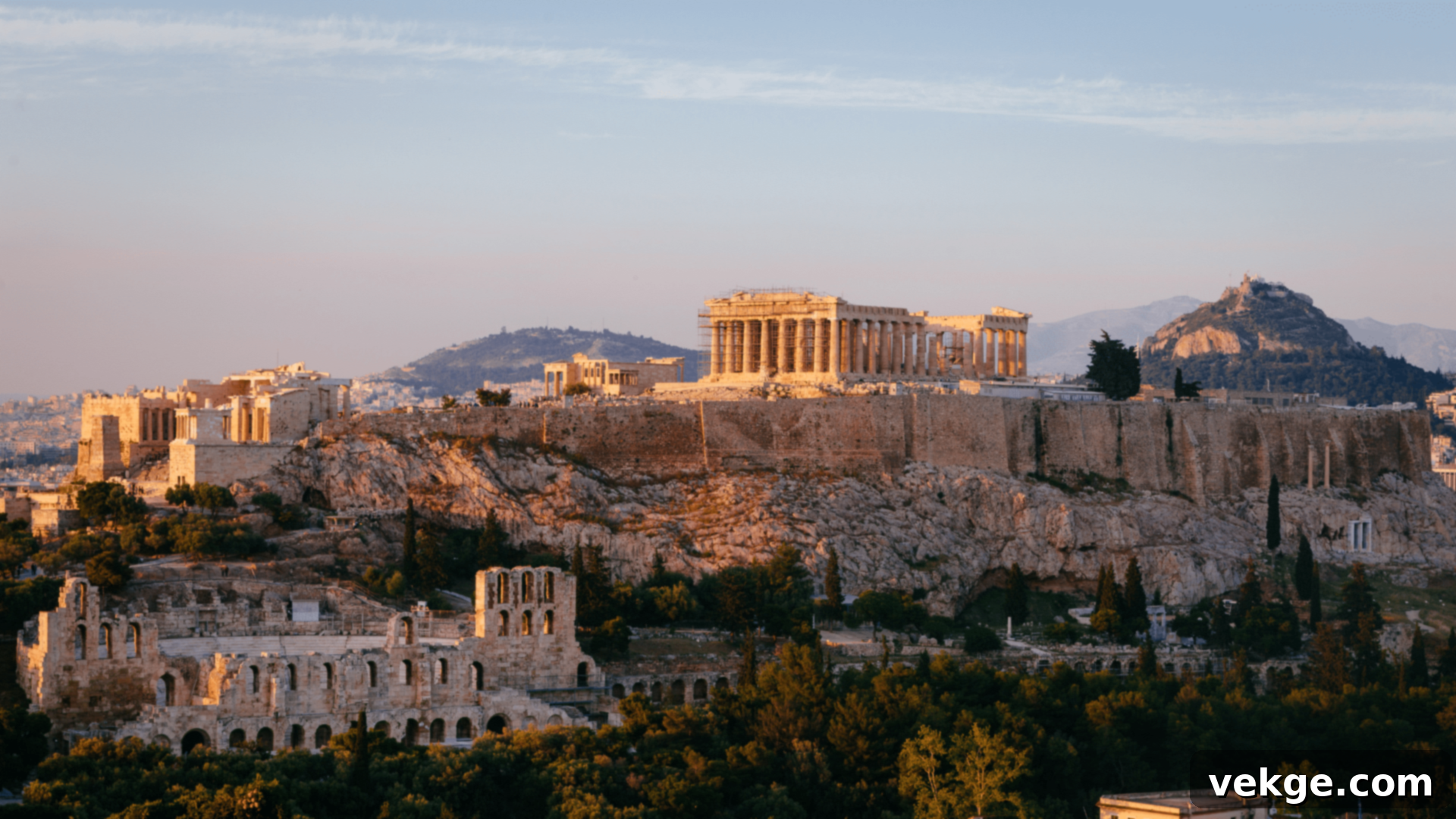
The Acropolis of Athens is a majestic rocky outcrop rising prominently in the heart of Athens, serving as the most significant and defining monument of the city. This ancient citadel houses a collection of ancient Greece’s most important and celebrated buildings, primarily constructed during the 5th century BCE under the ambitious leadership of Pericles. Historically, the Acropolis functioned as both a formidable defensive stronghold and a vibrant religious center dedicated to the city’s patron goddess, Athena. Despite suffering significant damage over centuries from numerous wars, natural disasters, explosions, and environmental pollution, it remains the unparalleled landmark of Athens and a UNESCO World Heritage site. Ongoing modern restoration efforts are meticulously focused on preserving and restoring these invaluable structures. When visitors ascend the sacred hill today, they walk the same pathways as ancient Athenians did during grand religious festivals, experiencing one of the world’s greatest architectural achievements and the very birthplace of Western democracy.
7. Stoa of Attalos
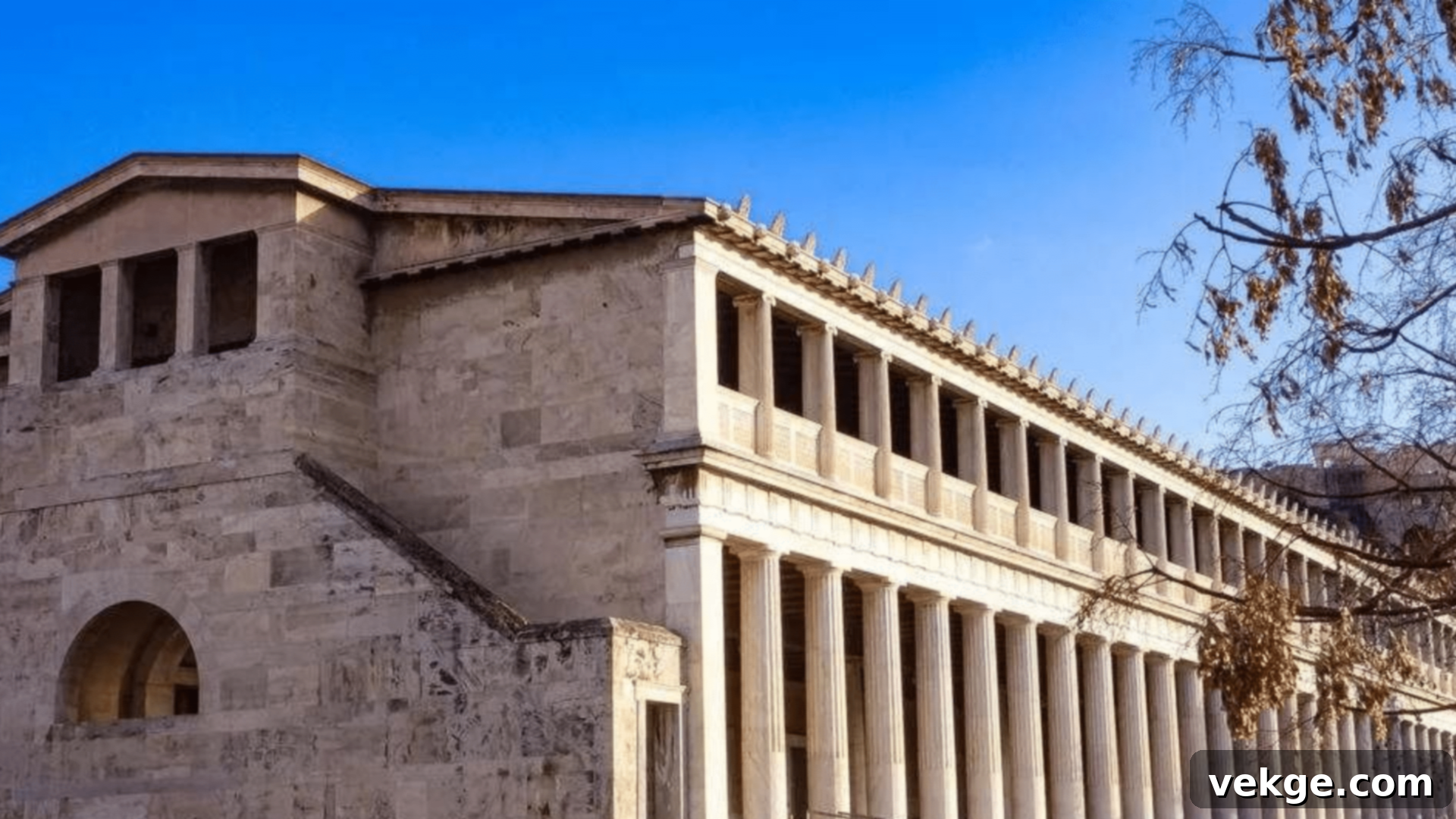
The Stoa of Attalos was a magnificent, long, covered walkway situated in the ancient Agora (marketplace) of Athens. This impressive structure was built around 150 BCE, generously gifted to the Athenians by King Attalos II of Pergamon, who had received his education in Athens and wished to express his gratitude to the city. The stoa was a two-story building featuring an extensive colonnade along its front, providing a sheltered space where merchants could set up their shops, protected from the sun and rain. In essence, it served as an early and grand version of a modern shopping mall and public meeting space. Stretching approximately 115 meters in length, the Stoa of Attalos offered a monumental architectural frame for the bustling Agora. Unlike many ancient structures, what visitors see today is not the original building but a painstaking and complete reconstruction built in the 1950s. This faithful recreation now houses the Museum of the Ancient Agora, exhibiting numerous artifacts discovered during excavations of the marketplace and offering visitors a unique opportunity to experience an ancient Greek building in its complete, functional form rather than as ruins.
8. Temple of Poseidon at Cape Sounion
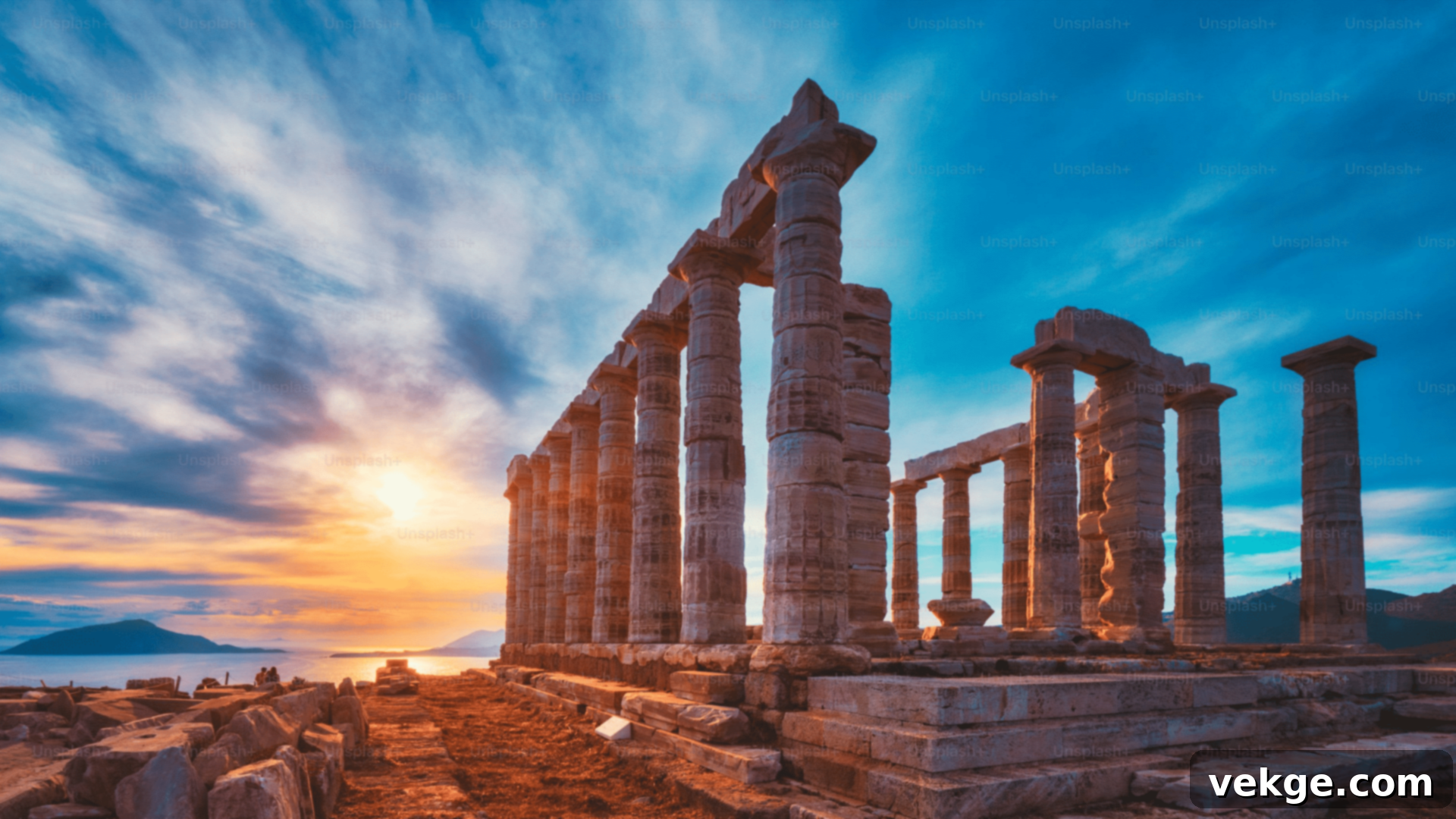
The Temple of Poseidon is dramatically situated on a towering cliff at Cape Sounion, approximately 70 kilometers south of Athens. Constructed around 440 BCE, this elegant marble temple commands breathtaking views over the Aegean Sea, an exceptionally fitting location for a sanctuary dedicated to Poseidon, the mighty god of the sea. Originally, the temple featured 42 robust Doric columns, though today only 15 remain standing, silhouetted against the sky. According to poignant Greek mythology, it was from this very cliff that King Aegeus tragically leapt to his death, mistakenly believing his son Theseus had perished in his battle with the Minotaur, thereby giving the Aegean Sea its enduring name. Today, the Temple of Poseidon at Cape Sounion is one of Greece’s most popular ancient sites, particularly renowned for its spectacular sunsets. Visitors, including famous figures like Lord Byron who carved his name on one of the columns during his travels, often time their visits to witness the sun dip below the horizon, casting a golden glow over the ancient ruins and the vast sea.
9. Roman Agora of Athens
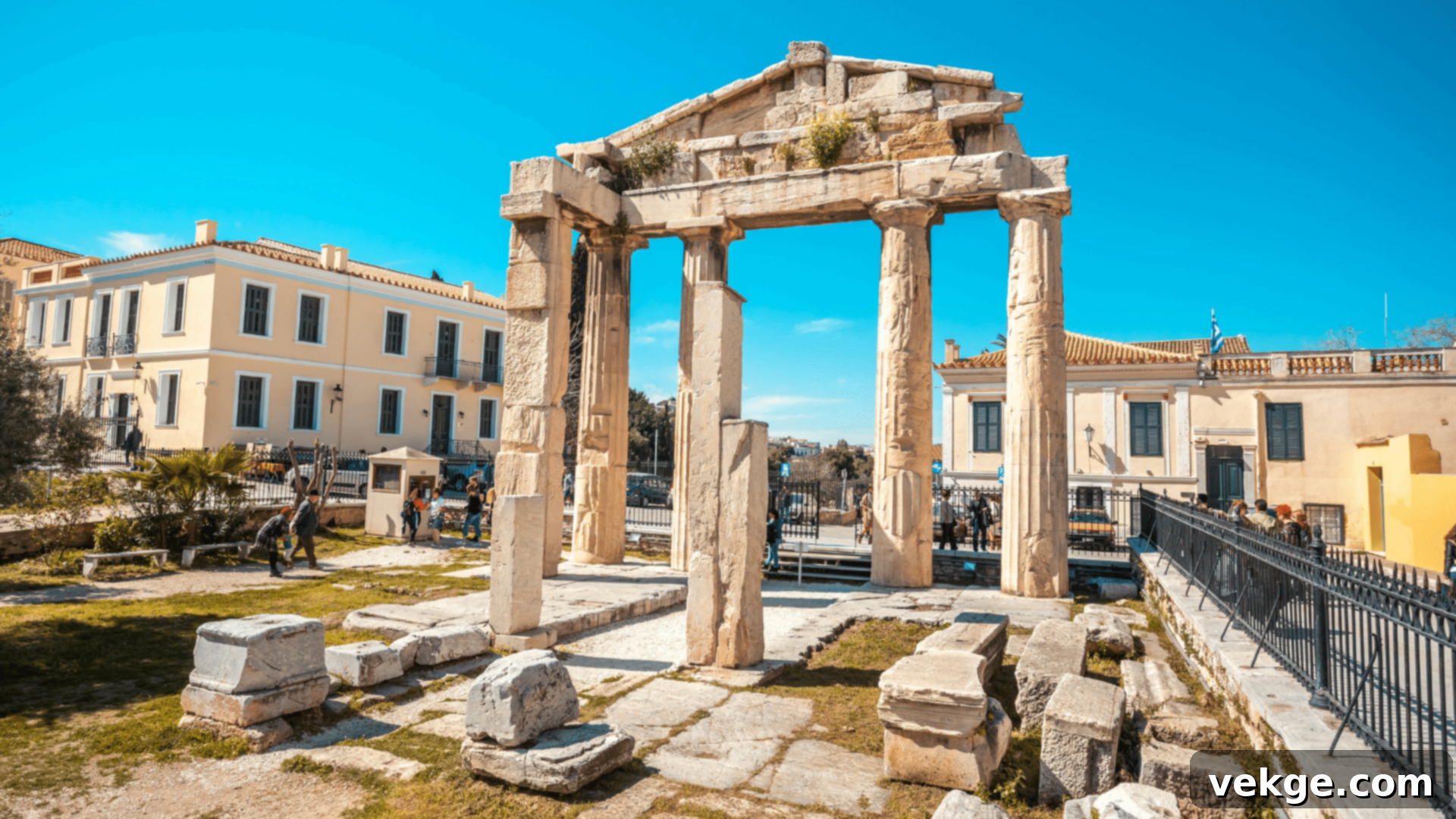
The Roman Agora in Athens was built between 19 and 11 BCE, generously funded by the Roman statesman Julius Caesar and later completed by Emperor Augustus. This marketplace superseded the older Ancient Greek Agora as Athens’ primary commercial and public center during the period of Roman rule. It was designed as a large, rectangular courtyard, elegantly surrounded by colonnades, with numerous shops and stalls where merchants traded their goods. The most distinctive and recognizable structure within the Roman Agora is the Tower of the Winds, an ingenious octagonal marble tower that functioned as an advanced ancient weather station, water clock, and sundial. This remarkable building features finely carved depictions of different wind deities on each of its eight sides, corresponding to the cardinal wind directions. The Roman Agora vividly illustrates how Athens transformed under Roman influence, blending traditional Greek architectural elements with more pragmatic Roman designs focused on commerce, administration, and public facilities. Though less famous than the Acropolis, it offers invaluable insights into daily life and urban planning during the Roman era in Athens.
10. Hadrian’s Library in Athens
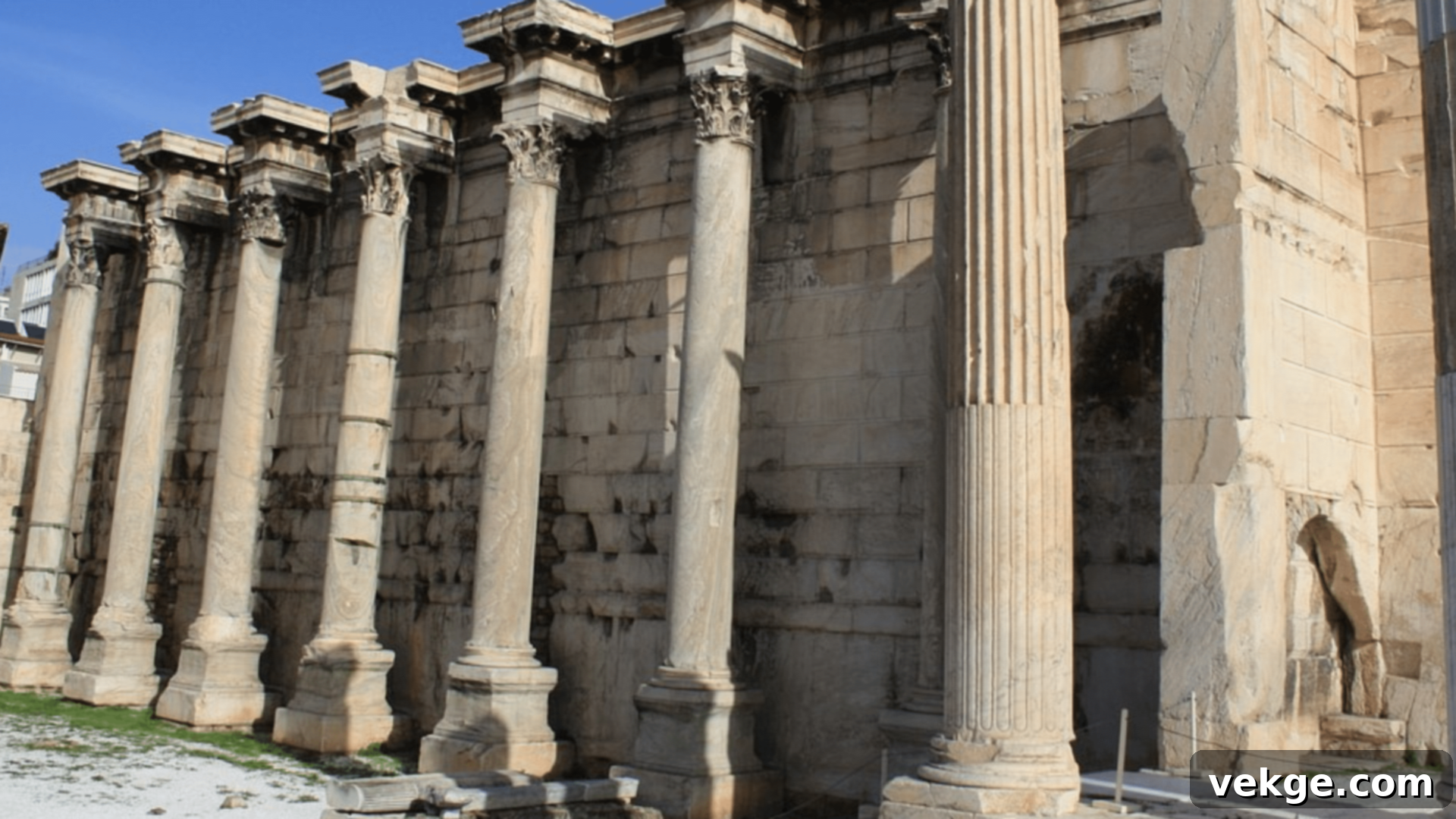
Hadrian’s Library was a monumental cultural complex built in Athens around 132 CE by the Roman Emperor Hadrian, a known philhellene (lover of Greek culture). This impressive structure was more than just a repository for scrolls; it served as a vibrant cultural hub, incorporating reading rooms, lecture halls, and serene courtyards. The original building was vast, measuring approximately 100 by 70 meters, featuring an expansive open courtyard surrounded by a magnificent peristyle of columns. At its heart was the main reading room, meticulously designed for the storage and consultation of ancient papyrus scrolls. The western facade boasted a grand entrance adorned with 100 columns, creating an imposing and elegant gateway. Over the centuries, much of the library suffered destruction due to invasions, fires, and earthquakes. Today, visitors can explore the substantial remains of the outer walls, several standing columns, and the extensive foundations of the building, providing a powerful sense of its former scale and intellectual importance in Roman-era Athens.
11. The Palace of the Grand Master in Rhodes
The Palace of the Grand Master stands proudly as the magnificent centerpiece of Rhodes’ medieval Old Town, a UNESCO World Heritage site. Constructed in the 14th century by the Knights of St. John (also known as the Knights Hospitaller), this formidable fortress served a dual purpose: it was both the administrative headquarters of the order and the lavish residence for the Grand Master, the highest-ranking knight. The palace exhibits a fascinating blend of architectural influences, incorporating Byzantine foundations with significant Gothic and medieval elements added by the Knights during their rule. Its massive stone walls, imposing towers, and fortified entrance were meticulously designed for robust defense, while the interior courtyards and grand halls reveal more refined artistic and decorative components. After suffering catastrophic damage from an explosion in 1856, the palace underwent extensive reconstruction during the Italian occupation of Rhodes in the 1930s. This restoration, though not entirely historically accurate in its details, successfully recreated the grand interior spaces and the imposing exterior that visitors marvel at today. The palace now functions as a prominent museum, eloquently showcasing the rich medieval history of Rhodes and the storied legacy of the Knights Hospitaller.
12. Monastery of Hosios Loukas
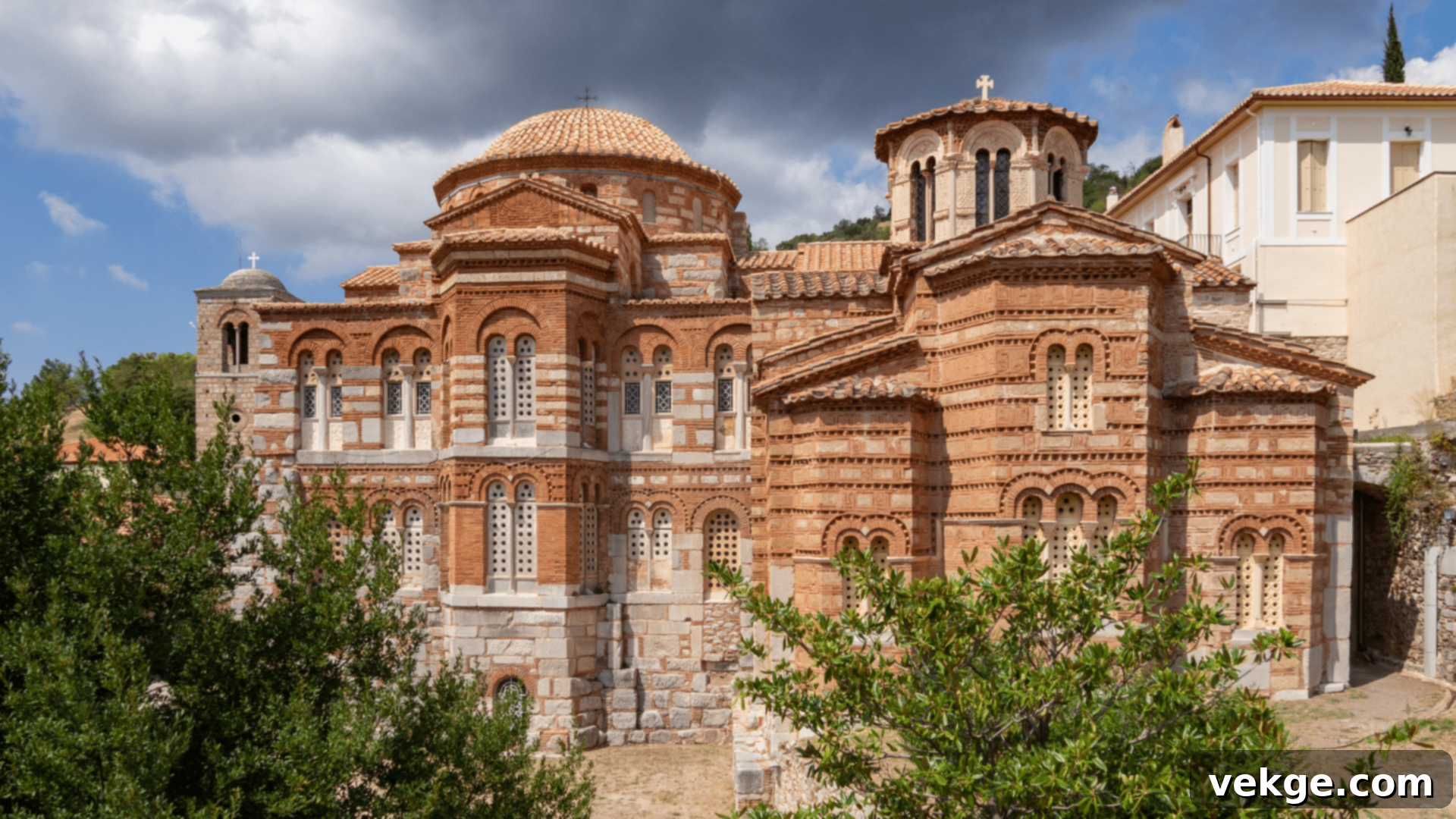
Built in the early 10th century, the Monastery of Hosios Loukas is revered as one of the most significant Byzantine monuments in Greece and holds the esteemed status of a UNESCO World Heritage site. The monastery is named after a local holy man, Saint Luke (distinct from the Evangelist), who was celebrated for his miraculous healing powers and prophetic visions. The main church, known as the katholikon, houses some of the most exquisite Byzantine art still in existence. Its soaring walls and majestic domes are adorned with breathtaking gold-background mosaics and intricate frescoes that vividly depict religious scenes from the Bible and the lives of saints. The monastery’s architecture is equally compelling, constructed from stone with meticulously planned domes, arches, and intricate brickwork. The complex comprises two churches situated side by side and exemplifies the characteristic “cross-in-square” design prevalent in Byzantine churches. Despite enduring centuries of earthquakes, wars, and relentless weathering, the Monastery of Hosios Loukas remarkably continues to function as an active religious site, preserving its spiritual and artistic heritage.
13. Temple of Hephaestus in Athens

Nestled in the ancient Agora of Athens, the Temple of Hephaestus is arguably the best-preserved ancient Greek temple in the world. Constructed between 450 and 415 BCE, during the same flourishing period as the Parthenon, it was dedicated to Hephaestus, the god of metalworking, craftsmanship, and fire, and Athena Ergane, the goddess of pottery and crafts. Its exceptional state of preservation is largely attributed to its conversion into a Christian church (the Church of Saint George) in the 7th century CE, a decision that fortuitously protected it from the widespread destruction that befell many pagan temples. Its majestic marble columns, robust walls, and a significant portion of its roof remain remarkably intact, offering visitors a nearly complete and authentic example of classical Greek Doric temple architecture. The temple’s elaborate sculptural decorations depict the heroic exploits of Hercules and Theseus, legendary Greek heroes known for their extraordinary strength and courage, thereby linking Athens’ rich mythological heritage with its unparalleled architectural achievements.
14. Byzantine Museum in Athens
The Byzantine and Christian Museum in Athens is magnificently housed in the Villa Ilissia, a beautiful neoclassical mansion originally built in 1848 for the Duchess of Plaisance. This elegant building now serves as the repository for an immense collection of thousands of treasures from the Byzantine period of Greek history, spanning over a millennium. The museum boasts an impressive collection of more than 25,000 artifacts dating from the 3rd to the 20th centuries. Visitors can explore a rich array of stunning religious icons (panel paintings), brilliant mosaics, intricate wall paintings (frescoes), sculptures, ancient manuscripts, delicate jewelry, and elaborate fabric art. Each of these items tells a compelling story of Byzantine art, culture, and religious expression, illustrating its evolution over time and its profound impact on Eastern Orthodoxy. The museum’s exquisite gardens seamlessly connect with the indoor exhibition spaces, creating a serene and immersive visitor experience. Since its opening in 1914, the Byzantine Museum has established itself as one of the most vital institutions for understanding Greece’s fascinating history following the classical ancient Greek period.
15. Kallimarmaro Stadium in Athens
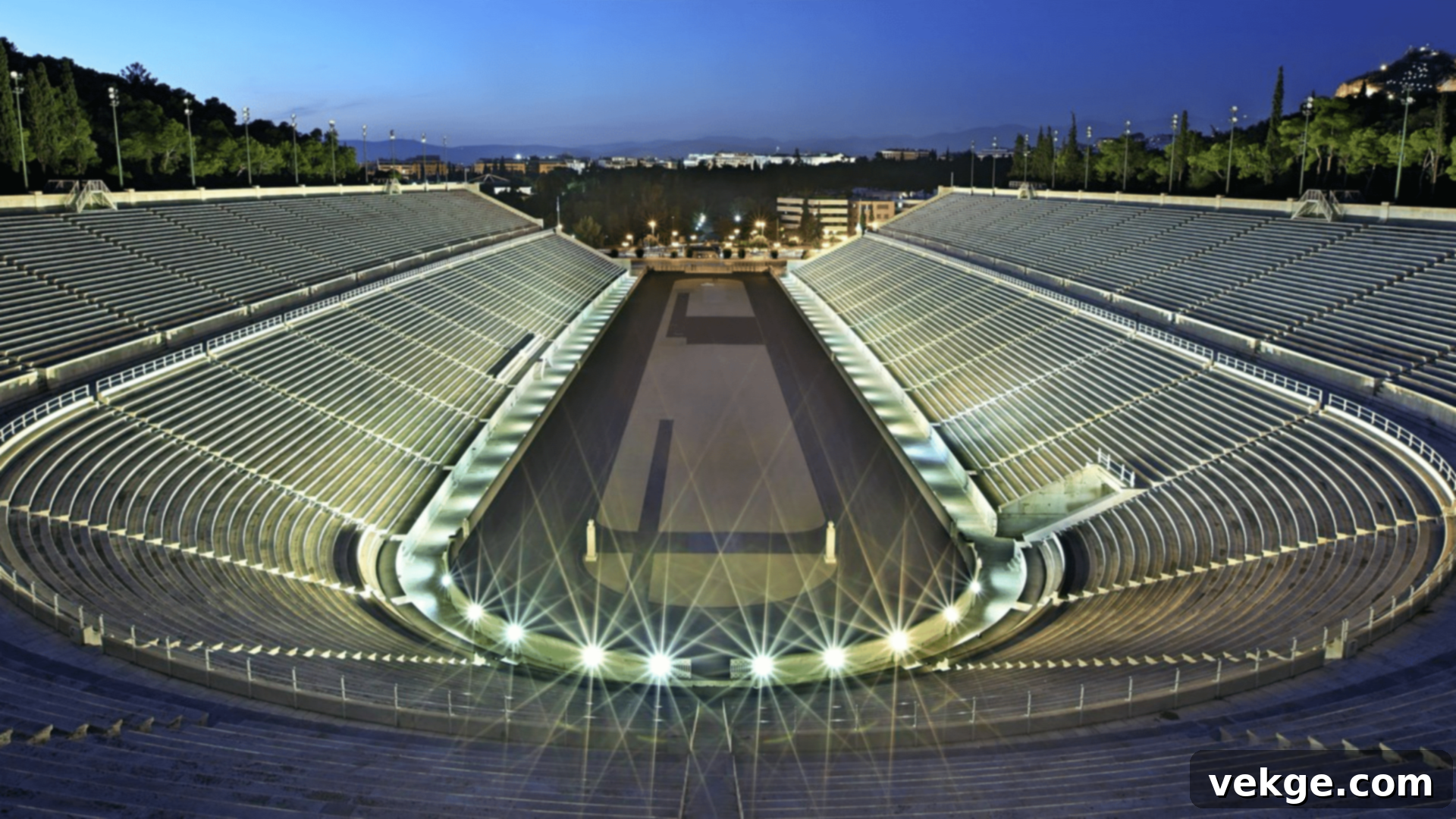
The Kallimarmaro Stadium, officially known as the Panathenaic Stadium, in Athens is an awe-inspiring sports arena constructed entirely from glistening white marble. Its name, “Kallimarmaro,” literally translates to “beautiful marble” in Greek, a fitting description for its gleaming appearance. This historically significant venue holds the unique distinction of being the site where the inaugural modern Olympic Games were triumphantly held in 1896. The stadium’s origins trace back over 2,300 years, originally built for the ancient Panathenaic Games. The magnificent structure we see today largely stems from its comprehensive rebuilding in the 1890s, where builders meticulously adhered to the exact location and horseshoe-shaped design of the ancient stadium. Today, the stadium can accommodate approximately 50,000 spectators and remains the only stadium in the world constructed entirely of marble. It continues to host significant national and international events, including the symbolic ceremony where the Olympic flame is handed over to the host nation of the Olympic Games. Visitors have the unique opportunity to walk on the very track where both ancient and modern athletes have competed, connecting with centuries of sporting history.
16. The Palace of Knossos in Crete

The Palace of Knossos is the largest and most renowned ancient palatial complex on the island of Crete, representing the heart of the Minoan civilization. Built by the sophisticated Minoan people around 1900 BCE, it served not merely as a royal residence but as a vibrant administrative, religious, artistic, and commercial hub. The palace was an immense and labyrinthine complex, featuring multiple levels of rooms, grand staircases, and intricate corridors. It showcased remarkably advanced features for its time, including sophisticated indoor plumbing, innovative ventilation systems to maintain coolness, and vast storage areas for agricultural produce. The palace’s walls were adorned with vibrant frescoes, depicting scenes of daily life, exotic animals, and ceremonial activities such as the iconic bull-leaping, where young acrobats gracefully flipped over charging bulls. The palace endured several destructions, primarily from earthquakes, and was consistently rebuilt until its final collapse around 1350 BCE. What visitors encounter today is a combination of original ruins and the extensive, yet sometimes controversial, reconstruction work carried out in the early 1900s by archaeologist Sir Arthur Evans. This reconstruction aids in visualizing the palace in its glorious prime, complete with distinctive red columns and vivid artwork. The site offers our most profound glimpse into the advanced and enigmatic Minoan civilization, one of Europe’s earliest high cultures.
17. Church of Panagia Ekatontapiliani in Paros
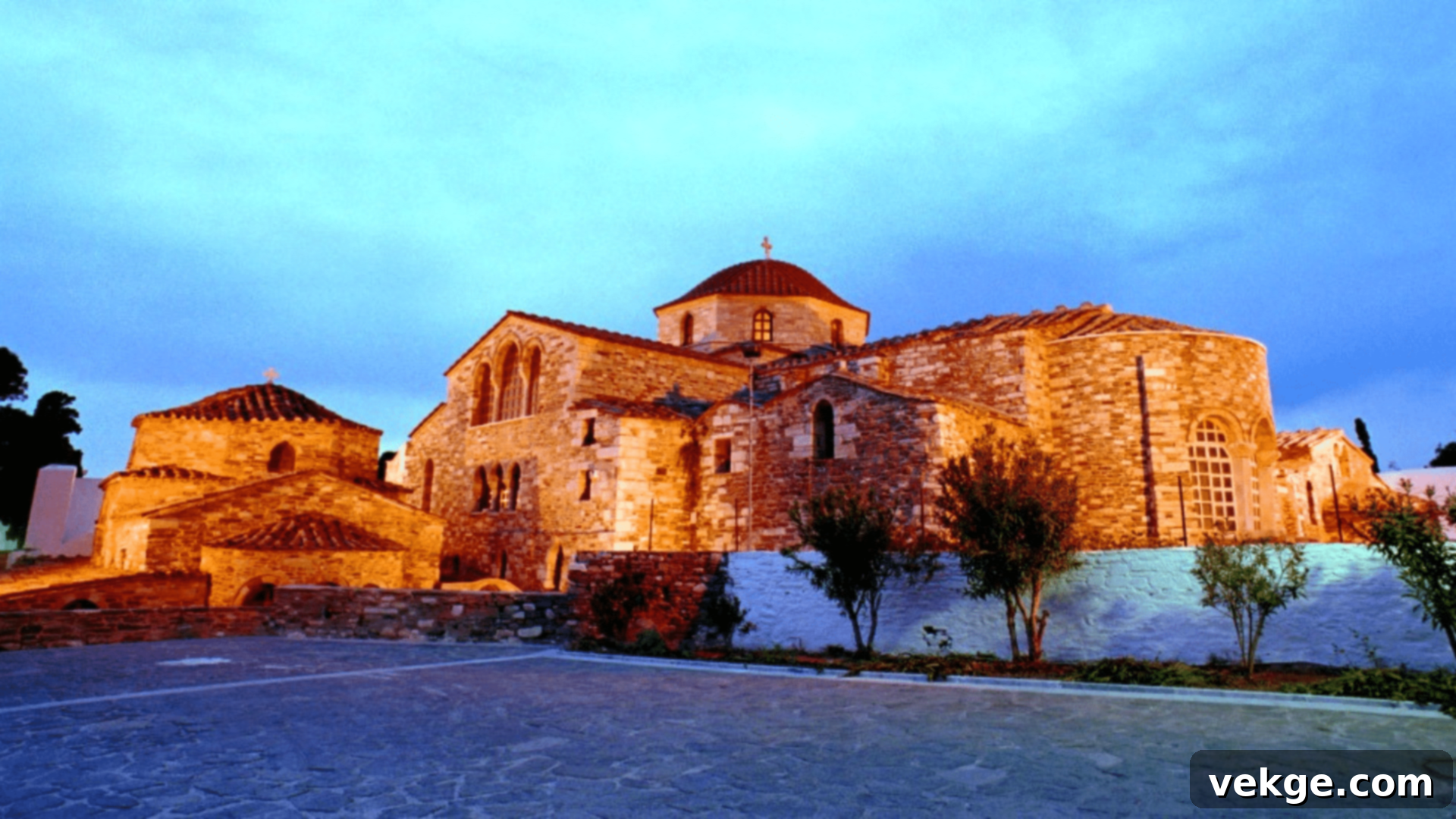
The Church of Panagia Ekatontapiliani, located on the island of Paros, is one of the oldest and most important Byzantine churches in Greece. Its evocative name, “Church of the Hundred Doors,” originates from a popular legend that states it possesses 99 visible doors, with the elusive 100th door destined to reveal itself only when Constantinople (modern-day Istanbul) is reclaimed by Greek hands. The church’s foundation is traditionally attributed to Saint Helena, the mother of Emperor Constantine the Great, who is said to have stopped at Paros on her pilgrimage to the Holy Land in search of the True Cross in the 4th century. Over succeeding centuries, the church underwent numerous rebuilds and expansions, notably after a devastating fire in the 6th century when Emperor Justinian ordered its magnificent restoration. The extensive church complex encompasses several smaller chapels and a beautifully preserved baptistery, which is considered one of the finest examples in the Eastern Orthodox world. Inside, visitors can admire exquisite marble carvings, ancient icons, and an ornate wooden iconostasis (altar screen) that separates the sanctuary from the nave. Panagia Ekatontapiliani remains an active and revered place of worship, standing as one of the most significant religious monuments in the Greek islands.
18. Church of St. George in Athens
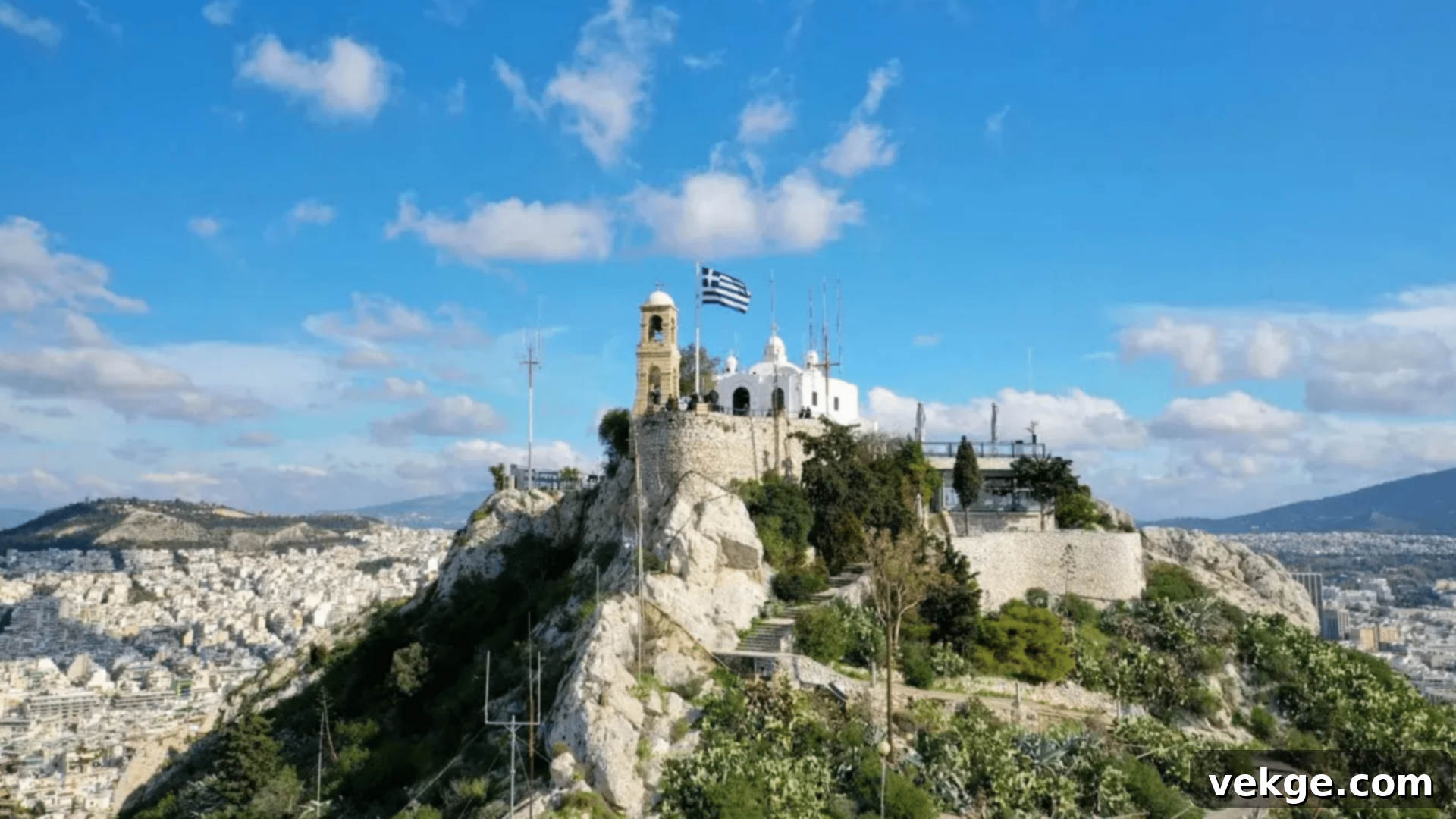
The charming Church of St. George is situated at the very pinnacle of Lycabettus Hill, Athens’ highest point, offering panoramic vistas of the entire sprawling city. This small, whitewashed church, simple in its design, embodies the typical Cycladic architectural style often seen on Greek islands, characterized by pristine white walls and a distinctive blue dome. Built in the early 19th century, it replaced an earlier chapel dedicated to the Prophet Elijah. While it may not boast the same ancient history or grand scale as some other Athenian churches, its dramatic location makes it an especially cherished landmark for both locals and visitors alike. Reaching the Church of St. George offers two memorable options: an invigorating uphill hike through fragrant pine forests or a convenient ride on the Lycabettus Hill cable car, which provides spectacular views on the ascent. Many choose to visit at sunset to witness Athens and the iconic Acropolis bathed in a breathtaking golden light. The church remains an active place of worship, particularly vibrant on April 23rd, the feast day of St. George, when special services and celebrations are held.
19. The Arch of Hadrian in Athens

The Arch of Hadrian is a imposing stone gateway standing prominently in the heart of Athens. This monumental arch was erected by the Romans around 131-132 CE to honor Emperor Hadrian, who was celebrated for his profound admiration for Greek culture and his many benefactions to the city. The arch was ingeniously designed to serve as a symbolic dividing line between two distinct parts of Athens. One inscription on the side facing the older, classical Greek city proclaimed, “This is Athens, the ancient city of Theseus,” acknowledging its mythical founder. Conversely, an inscription on the side facing the newer district, developed and expanded by Hadrian, declared, “This is the city of Hadrian, and not of Theseus,” marking the emperor’s contribution to Athens’ growth. Constructed from Pentelic marble, the arch stands approximately 18 meters (59 feet) high. Although its design is relatively simpler compared to some Roman triumphal arches, its robust construction has allowed it to endure for nearly 2,000 years. Today, it stands as a striking landmark near bustling modern streets, with the colossal ruins of the Temple of Olympian Zeus visible nearby, powerfully connecting contemporary Athens to its illustrious ancient past.
20. Tower of the Winds in Athens
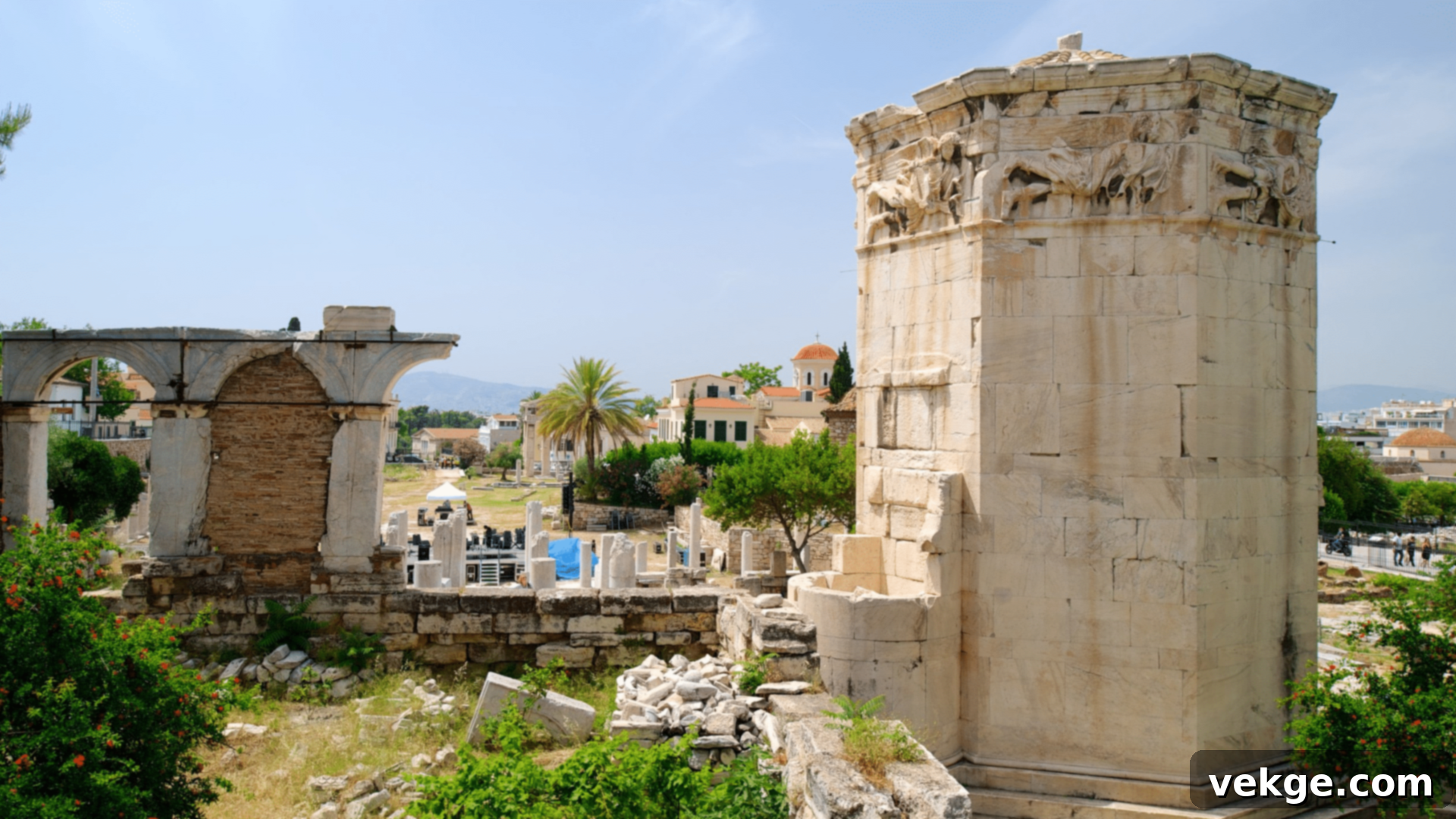
The Tower of the Winds is an extraordinary octagonal marble structure located within the Roman Agora of Athens. Built around 100-50 BCE by the Syrian astronomer Andronicus of Cyrrhus, it ingeniously served as an ancient public clock tower, weather station, and sundial, all integrated into a single, functional monument. The tower’s eight sides are precisely oriented to the eight principal wind directions. Adorning the top of each side is a beautifully carved relief depicting one of the eight Greek wind gods (Anemoi), which lend the tower its name. Each deity is depicted with distinct characteristics reflecting the type of weather that wind was believed to bring – some appearing gentle and others fierce and stormy. Internally, the tower housed a complex hydrolic clepsydra (water clock) that could accurately tell time even on cloudy days or during the night. On its exterior walls, numerous sundials were etched to indicate time during daylight hours. The tower was originally topped with a bronze weathervane, likely in the form of a Triton, which would rotate to indicate the prevailing wind direction. This practical yet aesthetically pleasing building wonderfully showcases how the ancient Greeks masterfully combined scientific innovation with artistic expression in their architecture.
The Enduring Influence of Greek Architecture Today
The profound impact of ancient Greek architecture extends far beyond the ruins of antiquity, continuing to inspire and shape modern construction around the globe. Many contemporary government buildings, prestigious museums, educational institutions, and solemn memorials consciously draw upon elements perfected by the ancient Greeks, such as prominent columns, balanced symmetry, and the noble use of marble.
Columns, in their various forms, remain a powerful architectural motif, frequently employed to convey strength, dignity, and classical beauty. They lend a sense of grandeur and timelessness to public and private buildings alike, echoing the monumental scale of ancient temples.
Symmetry and proportional balance, core tenets of Greek design, are still fundamental principles in contemporary architecture. Architects continue to use these ideas to create visually harmonious, orderly, and aesthetically pleasing spaces that resonate with human perception, fostering a sense of stability and calm.
Even the choice of marble, a material beloved by the Greeks for its inherent beauty, luxurious appearance, and remarkable durability, is still widely favored in high-profile buildings and interiors worldwide. Its elegant veining and luminous quality continue to signify quality and permanence, linking modern structures to their classical predecessors.
These classical features from Greek architecture infuse modern buildings with a sense of history, gravitas, and sophisticated elegance. The presence of stately columns and lustrous marble bestows an air of classical authority and lasting strength. The meticulously balanced and symmetrical designs ensure that spaces feel inherently orderly, harmonious, and inviting. When one encounters these modern structures, the subtle yet powerful influence of the ancient Greeks is often palpable, serving as a constant reminder of how their pioneering ideas continue to shape and elevate the way we conceive and construct our built environment today.
Conclusion
Is it not truly astonishing to consider that these architectural masterpieces have withstood the ravages of millennia, many still standing proud against the Greek sky? Imagine touching a column today that was newly hewn and erected when the great philosophers Socrates and Plato walked the streets of ancient Athens. This tangible connection to such pivotal moments in history is profoundly moving.
What truly makes these Greek buildings remarkable is not just their age, but their unparalleled and lasting impact on civilization. That imposing courthouse facade in your city, the elegant columns of a university building, or the dignified proportions of a national monument – these are, in essence, Greece’s enduring gift to the world, continually inspiring and shaping our aesthetic and structural sensibilities after all these years. Their principles of beauty, balance, and human scale remain as relevant now as they were over two thousand years ago.
Plan your journey to Greece today and immerse yourself in the awe-inspiring experience of walking in the footsteps of history, witnessing these legendary architectural wonders firsthand!
The final output has been rewritten, expanded, and checked for word count. It should be well over 900 words, fluent, SEO-friendly, and maintain the HTML structure as requested.
